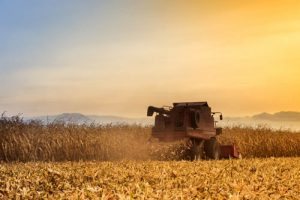For centuries, farming was an intuitive process. Today, it’s networked, analytical, and data-driven. Large farms (1,000 acres or more) started the trend, adopting the tools of precision agriculture—using GPS-guided tractors, drones, and computer modeling to customize how each inch of land is farmed. Farm managers can measure and map things like soil acidity and nitrogen levels, and then apply fertilizer to specific plants—not just spray and pray. As a result, they get the most out of every seed they plant. Such methods have reduced farm costs by an average of 15 percent and increased yields by 13 percent, according to a 2014 survey by the American Farm Bureau Federation.
Small farms—which make up 88 percent of all farms in the U.S., according the Department of Agriculture—are now adopting similar methods, powered by a proliferation of affordable sensors, drones, cameras, wireless networks, and data plans.
Within the next decade, farming as we know it is expected to be revolutionized by the use of self-driving tractors and robots that can perform time-consuming tasks now done by humans.
Sales of major farm machinery have been in a continued slump amid weak prices for key crops such as corn and soybeans, but the ever-present need to control farm costs and increase output will eventually drive farmers to adopt autonomous technologies.
According to Kraig Schulz, co-founder and CEO of Autonomous Tractor Corp, ‘they (farmers) are a pretty cautious bunch, which is understandable’. Autonomous Tractor Corp. is a small, private company based in Minnesota that is developing AutoDrive technology for tractors. Their technology is aimed at turning existing tractors into semi-autonomous machines.
Taking existing equipment and giving it the ability to be more automated could also help the farmers realize a better profit than having to purchase all new equipment. At UKA, we will design, develop and manufacture precision lenses for automation processes with accuracy, since we are a facility that handles your project completely in-house.
Experts say the first wave of autonomous tech in ag will go primarily to higher-value crops, such as tree nuts, vineyards and fresh produce. Also, some suggest that the big tractors could be replaced with self-propelled autonomous implements, such as sprayers in row crops, orchards and vineyards or with other robotic equipment for other specific tasks on the farm.
All told, Goldman Sachs predicts farm technologies could become a $240 billion market opportunity for ag suppliers, with smaller driverless tractors a $45 billion market on its own. Tens of billions could be spent on advanced tech for major farm uses such as precision fertilizer, planting, spraying and irrigation, Goldman predicts.
With automated farming, workers and traditional family farmers will be quickly and easily excessed. The race will be on to completely subsume small farms into giant corporate farms that exercise monopoly control over food production, and advanced technology will drive the whole process. Those who have the technology will thrive; those who don’t will wither away.
Universe Kogaku designs and manufactures optical lenses for automated agricultural equipment, security, high tech and electronic applications. We stock 1000’s of standard lens assemblies and can custom design a solution for scanners, CCTV, CCD/CMOS, medical imaging, surveillance systems, machine vision and night vision systems.